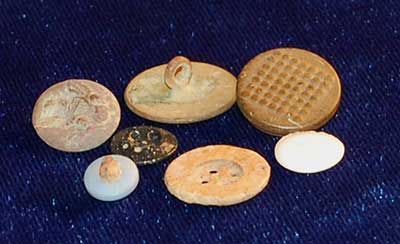Most of what is known about Camp Nelson comes from official records written by Union Army officers and civilian government officials. There are relatively few written accounts from the perspective of the common soldiers or enslaved refugees. In order to help fill this void, archaeologists conducted investigations at several sites within Camp Nelson, beginning in 1987. Among the buildings that have been investigated are the Owen's House and the Refugee's Encampment site.
The Owen's House/Post Office Complex was Camp Nelson’s main commercial district. It addition to these two buildings, the complex included a photographic studio, sutlers’ stores (private merchants to the army), a billiards parlor, a shoe/boot store, and some as-yet-unidentified buildings. Artifacts such as expensive ceramics, wine bottles and glasses, officers’ buttons and accoutrements, and expensive cuts of meat, helped archaeologists determine that the Owen's House was a tavern for higher-class clientele, such as officers and supervisory employees. The quality and variety of artifacts found at two other areas within this complex helped identify them as a sutler store and saloon, both of which served a lower-class clientele, such as enlisted men and laborers.
A variety of foodways, clothing, and architectural artifacts found in a poorly known area of the depot, suggested that it was a habitation site and probably an encampment associated with Camp Nelson. But who had lived there? The discovery of necklace beads and doll parts pointed to the presence of women and children, while the discovery of two charms/amulets - a button inscribed with an “X” and a pierced silver coin - suggested that they were of African descent. When combined with historical documents, these discoveries, along with the many burned artifacts recovered, suggested that this was the site of a pre-expulsion refugee encampment, destroyed and burned in November 1864. The presence of a large quantity of clothing items, including small seed beads, tube beads, and a tremendous variety of buttons, suggests that these refugees were supporting themselves by doing laundry outside of their huts. This vital service allowed them to survive and create a community within Camp Nelson, at least temporarily.
